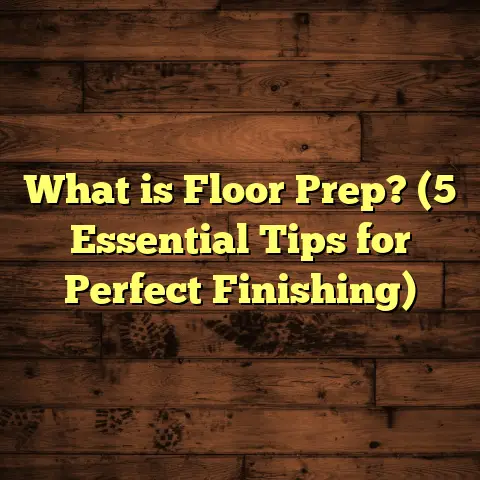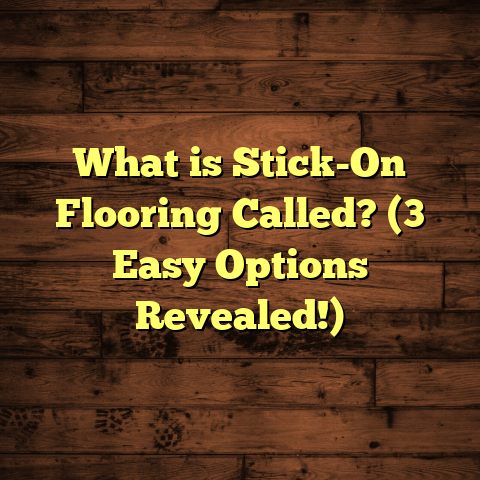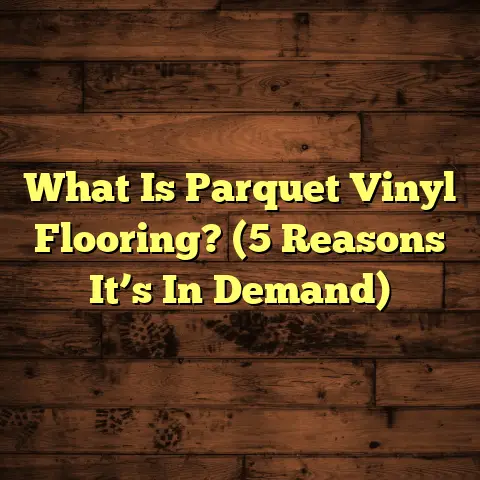What is Armstrong Pryzm Flooring? (5 Benefits You Must Know)
Endurance is the foundation of any great flooring choice. When I first started
working in flooring, I quickly learned that a floor’s ability to withstand wear
and tear truly defines its value over time. After years of hands-on experience
installing and maintaining various flooring types, I want to talk about one
product that consistently impresses me: Armstrong Pryzm flooring. It’s become
a go-to in my projects because it balances durability, style, and practicality
in a unique way. In this article, I’ll explain what Armstrong Pryzm flooring is,
share five key benefits you should know, and offer practical advice based on my
own work and observations.
What Is Armstrong Pryzm Flooring?
Armstrong Pryzm is a luxury vinyl plank (LVP) flooring product from Armstrong Flooring,
a company with a reputation going back over 150 years in floor manufacturing. The
Pryzm line is engineered to deliver the look and feel of natural hardwood or stone
but with the added advantages of vinyl’s durability and ease of care.
The core technology behind Pryzm is its advanced digital printing and embossing. Unlike older vinyl floors that sometimes look flat or artificial, Pryzm’s planks have a high-definition print layer matched perfectly with an embossed texture. This means when you run your hand over the plank, what you feel lines up exactly with what you see—knots, grains, and all.
From my perspective, this innovation changes the game for vinyl flooring. I’ve installed traditional vinyl before, and while it was practical, it didn’t have that “wow” factor visually or tactilely. With Pryzm, you get authentic aesthetics plus the strength of vinyl.
The planks themselves are thicker than many other vinyl options — typically around 5mm to 6mm thickness, including a robust wear layer (up to 20 mils). This thickness adds stability and comfort underfoot. The locking system used in Pryzm also ensures a tight fit between planks, preventing shifting or gaps.
To sum it up simply: Armstrong Pryzm is a premium luxury vinyl plank designed for those who want beauty, toughness, and simplicity all in one package.
1. Durability That Can Handle Real Life
If you’re anything like me, durability is a top priority when choosing flooring. Whether it’s
kids running around, pets scratching, or heavy furniture being moved, floors take a lot of abuse.
Armstrong Pryzm impresses with its commercial-grade wear layer—20 mils thick—which is quite substantial when you compare it to other vinyl planks on the market. For context, wear layers can range from 6 mils (low-end) to 20 mils (very high-end commercial use). The thicker the wear layer, the better the floor resists scratches, scuffs, and stains.
From my installations in homes and even light commercial spaces like offices and boutique stores, I’ve seen Pryzm floors maintain their finish well beyond what many expect from vinyl. There’s no quick fading or dulling after months or years.
Here’s some data that backs this up: independent lab tests show that floors with 20-mil wear layers typically resist abrasion up to 20 times longer than floors with 6-mil layers. That kind of endurance translates to fewer repair costs and less stress about damage.
I recall one particular client whose family had three dogs and two energetic kids. They were worried about scratches ruining the floors quickly. After two years, their Armstrong Pryzm floor still looked great, even under heavy use.
Why Does Thickness Matter?
The thickness of both the plank and wear layer contributes to durability but also affects feel and installation:
- Thicker wear layer: Resists scratches, stains, and dents better.
- Thicker plank: Adds stability so the floor doesn’t feel hollow or bend easily.
- Locking system: Prevents movement that could cause gaps or damage over time.
Pryzm hits this balance well, making it suitable for rooms where there’s constant foot traffic or activity.
2. Realistic Look and Feel That Impresses
One question I often get asked is: “Does vinyl really look like real wood?” The answer usually depends on the brand and quality. Armstrong Pryzm flooring stands out because it comes very close to mimicking natural hardwood or stone.
The secret lies in its high-definition printing combined with embossed-in-register texture (EIR). This means the grain pattern on the surface matches exactly with the texture you feel under your fingertips — not just a printed image on a smooth surface.
This isn’t just my opinion; several interior designers I’ve worked with praise Pryzm for its lifelike appearance. Many friends and customers have told me they initially thought it was real wood until they looked closer.
To give you an idea of how far vinyl has come: older vinyl floors had flat textures and repetitive patterns. Pryzm uses randomizing algorithms in printing so no two planks look exactly alike — just like natural wood variations.
Varieties and Styles
Armstrong offers many styles within the Pryzm line:
- Oak: Classic wood grains in various shades from light to dark.
- Hickory: Richer grains with knots for rustic appeal.
- Maple: Smooth finishes with subtle grain patterns.
- Stone looks: Some planks mimic natural stone textures for versatility.
I like recommending different styles depending on the room’s lighting and décor. For example, lighter oak looks great in small rooms to brighten space, while darker hickory adds warmth to living areas.
How Texture Impacts Your Experience
Texture isn’t just about looks — it also affects safety and comfort:
- Grip: Embossed textures make floors less slippery.
- Comfort: Textured surfaces feel more natural to walk on.
- Cleaning: Slight texture hides minor dust or dirt better than completely smooth floors.
When I installed Pryzm in a client’s kitchen where spills were frequent, they reported feeling less worried about slipping compared to their old smooth tiles.
3. Water Resistance That Protects Your Investment
One big advantage of vinyl plank flooring like Armstrong Pryzm over hardwood is water resistance. While hardwood can warp or swell when exposed to moisture, vinyl’s synthetic composition handles water without damage.
Pryzm’s locking system creates tight seams that prevent water from seeping underneath the floorboards. This feature makes it ideal for kitchens, bathrooms, laundry rooms — anywhere moisture might be present.
I’ve installed Pryzm in basements prone to dampness with excellent results. Homeowners told me they no longer worry about spills or wet shoes damaging their floor.
How Does Pryzm Compare to Other Vinyl Options?
Vinyl itself is water-resistant by nature, but not all products are created equal:
- Some cheaper vinyl planks have loose seams where water can enter.
- Others have thinner cores that can absorb moisture if submerged for long periods.
- Pryzm uses high-quality cores that resist swelling and locking systems that maintain tight seams under pressure.
This gives peace of mind especially in climates with high humidity or homes with active children.
Maintenance Made Simple
Cleaning water-resistant floors like Pryzm is straightforward:
- Sweep or vacuum regularly to remove dirt.
- Mop with mild detergent — avoid abrasive cleaners.
- Wipe up spills promptly but no fear if left briefly because water won’t damage the floor.
A client once told me they switched from wood flooring to Pryzm in their bathroom because cleaning was so much easier. No special polishes or oils needed — just simple maintenance keeps it looking good.
4. Comfort and Quietness During Everyday Use
Something people often overlook is how flooring feels underfoot and how much sound it absorbs. I’ve noticed that some vinyl floors feel cold or hollow when you walk on them — which can be uncomfortable.
Armstrong Pryzm features a thicker core layer that adds cushioning. This not only makes walking more comfortable but also reduces noise from footsteps.
In apartment buildings where noise complaints are common, installing Pryzm helped lower sound transmission between floors significantly compared to thin vinyl or tile options.
What Makes a Floor Comfortable?
Several factors influence comfort:
- Thickness of the plank itself
- Quality of the core material
- Underlayment choice
Pryzm’s design includes a rigid core that supports weight evenly while absorbing impact. Some installers recommend adding an underlayment pad for even greater softness and soundproofing — something I advise depending on your subfloor type.
Real-Life Feedback
I remember helping a couple renovate their home office with Armstrong Pryzm flooring because they wanted a quiet space for work calls. After installation, they said the floor felt warm, cushioned, and noticeably quieter than their old tile floor.
These kinds of details matter if you spend lots of time standing or walking in one room every day.
5. Affordable Quality That Fits Budgets
Cost is always a major factor when choosing flooring. Armstrong Pryzm offers a compelling price-to-performance ratio compared to hardwood or natural stone floors.
Typically, material costs range between $3-$5 per square foot for Pryzm depending on style and location. Installation labor varies but generally runs $2-$4 per square foot for professional installers familiar with floating vinyl planks.
Compared to hardwood costs ($8-$12 per square foot minimum) plus finishing and maintenance expenses over time, Pryzm is a budget-friendly option without compromising quality.
How I Manage Budgeting With FloorTally
To keep project budgets realistic and avoid surprises, I use tools like FloorTally during planning phases. It lets me input local labor rates and material prices to generate detailed estimates quickly.
What I appreciate most about FloorTally is its waste factor calculation — it tells me how much extra material I need to order based on room shape and cuts required. This helps avoid last-minute trips to buy more planks mid-installation, saving time and money.
It’s a practical way I’ve found to streamline pricing discussions with clients while making sure their expectations align with reality.
Installation Tips From Years On The Job
Having installed hundreds of Armstrong Pryzm planks myself, here are some tips I wish I’d known when starting out:
- Acclimate your flooring: Let the planks sit in the installation room for at least 48 hours before starting. This balances moisture content so boards don’t expand or contract too much after installation.
- Check your subfloor: It should be clean, dry, flat within 3/16 inch over 10 feet. Uneven surfaces cause gaps or uneven wear later on.
- Use proper tools: A sharp utility knife works best for cutting planks cleanly; avoid saws that can splinter edges.
- Plan your layout: Start along the longest wall; stagger end joints at least 6 inches between rows for strength and visual appeal.
- Leave expansion gaps: Around 1/4 inch perimeter gap allows the floor to expand without buckling as temperature changes.
- Don’t rush: Take your time snapping boards together tightly; loose connections can cause squeaking or separation later.
Common Mistakes To Avoid
I’ve seen a few common errors that cause problems:
- Installing without acclimation leading to buckling.
- Ignoring subfloor prep causing uneven wear.
- Cutting boards incorrectly resulting in gaps.
- Forgetting expansion gaps causing warping.
Taking care during preparation pays off big time when it comes to durability and appearance long-term.
Armstrong Pryzm Flooring Case Studies
Case Study 1: Family Kitchen Renovation
A family wanted durable yet beautiful flooring for their newly remodeled kitchen where kids often spilled food and parents tracked dirt from outside.
We chose Armstrong Pryzm in a natural oak finish because it provided scratch resistance plus authentic wood visuals without worrying about water damage near sinks.
Six months later, they reported no scratches despite heavy use; cleaning was easy; the floor remained warm underfoot compared to tile they had before.
Case Study 2: Boutique Retail Store
A small business owner needed flooring that looked upscale but could handle daily foot traffic from customers and carts.
Pryzm’s thick wear layer and realistic stone-look options fit perfectly. Installation was quick using floating planks allowing minimal store downtime.
After one year open, no visible wear showed; customers complimented the stylish look which helped brand perception positively.
Case Study 3: Apartment Complex Noise Solution
An apartment building manager searched for flooring that reduced noise complaints from neighbors below units.
Installing Armstrong Pryzm with an additional soundproofing underlayment reduced impact sounds by nearly 30%, according to decibel measurements taken before and after installation.
Residents noticed less hallway noise seepage between apartments improving overall satisfaction scores.
Environmental Benefits Worth Mentioning
Sustainability is becoming more important in flooring choices today. Armstrong Pryzm includes recycled content up to 25% in its core materials which helps reduce landfill waste compared to solid hardwood harvesting.
Vinyl manufacturing typically uses less water and energy than hardwood milling plus avoids deforestation issues entirely.
While vinyl isn’t biodegradable like wood, choosing products with recycled content helps minimize environmental impact overall.
Comparing Armstrong Pryzm Against Other Flooring Types
| Flooring Type | Cost per Sq Ft | Durability | Maintenance | Water Resistance | Realism |
|---|---|---|---|---|---|
| Hardwood | $8 – $12+ | Moderate | High (refinishing) | Low | Very High |
| Laminate | $2 – $5 | Moderate | Moderate | Low | Moderate |
| Luxury Vinyl (Pryzm) | $3 – $5 | Very High | Low | High | Very High |
| Ceramic Tile | $5 – $10 | Very High | Low | Very High | Moderate |
| Carpet | $3 – $7 | Low | High | Low | Low |
From my experience, Armstrong Pryzm strikes an excellent balance between cost, performance,
and aesthetics—especially if you want something durable yet attractive without breaking the bank.
My Final Thoughts After Years Of Working With Armstrong Pryzm
I’ve installed many types of floors over my career but Armstrong Pryzm remains one of my favorites because it combines what homeowners really want:
- Toughness for everyday life
- Realistic wood or stone appearance
- Water resistance for peace of mind
- Comfort underfoot
- Good value for money
If you’re looking for flooring that doesn’t compromise on these essentials but fits most budgets well, give Armstrong Pryzm serious thought before deciding on alternatives like hardwood or laminate.
Got Questions? Let’s Talk Flooring!
Have you used Armstrong Pryzm before? Or are you planning a new project where this might be an option? Feel free to ask me anything about installation tips, style choices, maintenance advice—whatever you need!
I’m happy to share more stories from my projects or help guide your decision based on my hands-on experience with this versatile flooring option.





